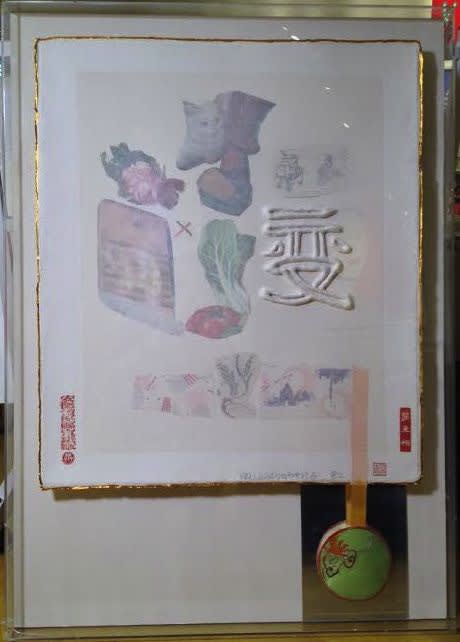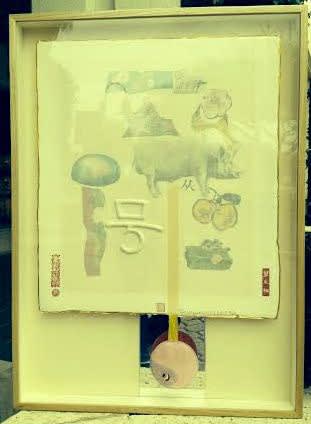Robert Rauschenberg 1925-2008
There is no reason not to consider the world as one gigantic painting. – Robert Rauschenberg
Robert Rauschenberg believed that art could change the world. As a mature, successful artist, he traveled extensively around the world. In 1984, he established the Rauschenberg Overseas Culture Interchange (R.O.C.I.), sharing his expertise with artists in other countries and learning about artistic traditions from his host country’s artists. After a dozen trips to countries around the world, Rauschenberg exhibited the works inspired by his travels at the National Gallery of Art in Washington D.C.
When he visited China, Rauschenberg collaborated with papermakers at the Xuan Paper Mill in Jingxian to create a series of collages based on seven Chinese characters.
To create the Seven Character Series, Rauschenberg used a base of thirty-ply paper covered with a layer of silk He then added a character to each work in pulp relief. On top of the base he placed images from posters that he found in Shanghai, attached and overlaid with a thin transparent paper. To finish off each work, Rauschenberg applied gold leaf and hung a cloth medallion on each work. These works were included in the ROCI CHINA exhibition held at the National Art Gallery in Beijing in 1985. Works from the Seven Character Series are available at VFA.
Much of what led to Robert Rauschenberg becoming one of the most influential and avant-garde artists of the twentieth century were serendipitous events. He was born and raised in a strict, religious family in the small, refinery town of Port Arthur, Texas. He planned on becoming a minister, but the ban on dancing in his family church changed his mind. His parents sent him to the University of Texas in Austin to study pharmacology, but he was expelled in his freshman year after he refused to dissect a frog. He was drafted in 1943. The letter from the draft board was his excuse not have to tell his parents about his expulsion.
He did tell the army that he was a conscientious objector, and was assigned to work as a medical technician in the Navy Hospital Corps, caring for combat survivors in San Diego. It was during one of his leaves that he visited the Huntington Art Gallery in California and saw his first oil paintings. The visit changed the trajectory of his life and he began to study art.
In 1950, he moved to New York, where he used found objects that he used to create the combines that centered around his belief that what artists create can be freely interpreted by each viewer.
When he moved to Florida’s Captiva Island in 1970, where he lived for nearly forty years, the objects he found there were very different than the ones he found in the streets of New York.
He was surrounded by beaches, and was influenced by the color and texture of the sand. The combines he created during those years are sleeker and more architectural than his earlier works.
Works that he made when he moved to Captiva are currently on view at the Gladstone Gallery in New York. The works were influenced by his travels abroad and his new surroundings off the Gulf Coast.
Robert Rauschenberg: Venetians and Early Egyptians, 1972-1974 will be on view at the Gladstone Gallery through June 18, 2022.
Please contact us if you would like more information about the works of Robert Rauschenberg available at VFA.
Catherine Yang. Seeing Robert Rauschenberg for the First Time, All Over Again. Hyperallergic. June 8, 2022.
Beatrice Johnson. Sand Into Stone: (Untitled) Early Egyptian and the Personal Myths of Robert Rauschenberg and Cy Twombly. Robert Rauschenberg Foundation. (June 14, 2022).




